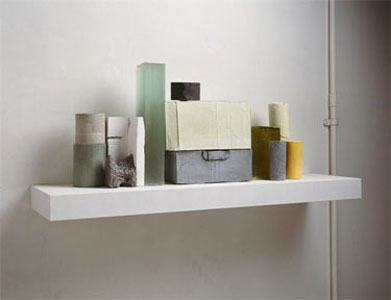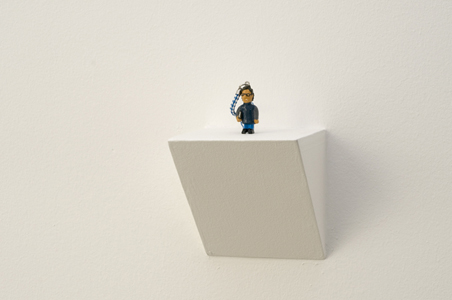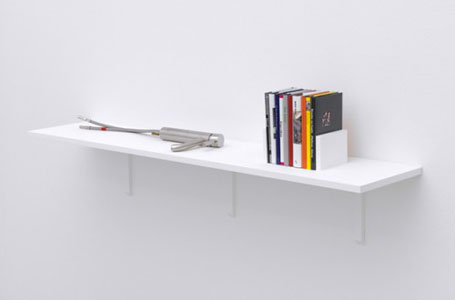


25.09.2010
From left to right :
TOP
Shinichi Takeda , Formalist's Bookshelf, 2010.
Jannis Kounellis , Untitled, 1983.
Carol Bove , Conversations with Luis Borges, 2002.
Ceal Floyer , Helix, 2002.
Nathaniel Russell , fake books, 2010.
Aloïs Godinat , Gentiane, 2010.
Pipilotti Rist , Enlight My Space, 2008.
Pierre Joseph , From Apple Core to Glass, 2010.
MIDDLE
Patrick Jackson , Chachka Structure.
Lenka Clayton , Intact, 2008.
Xavier Veilhan 's personal library, photo by The Selby.
Adrien Guillet , Shelves Sculptures, 2010.
Mathieu Mercier , Drum and Bass 2, 2002.
IOP , Lazy Library, 2010.
Haim Steinbach on Mike Kelley, 2008.
LOW
Rachel Whiteread , Green Model, 2007-08.
Matthew Brannon , Iguana, 2009.
Matthew Smith , Typical Affair, 2006.
Peter Liversidge , Proposal No. 67: Shelf with Found Objects, 2010.
Nina Canell ,To be hidden and so invisible, 2008.
Gareth Moore , Uncertain Pilgrimage, Glasses for Going West, 2006/2007.
Ryan Gander , Absorbing the sounds and the sights, 2009.
Didier Mencoboni , Etagère VII sur étagère VIII 1991-1995.
Evariste Richer , CMYK, 2009.
Jun Yang , Somewhere over the rainbow I, 2006.
Bernadette Corporation , go girl, 2010.
From left to right :
TOP
Shinichi Takeda , Formalist's Bookshelf, 2010.
Jannis Kounellis , Untitled, 1983.
Carol Bove , Conversations with Luis Borges, 2002.
Ceal Floyer , Helix, 2002.
Nathaniel Russell , fake books, 2010.
Aloïs Godinat , Gentiane, 2010.
Pipilotti Rist , Enlight My Space, 2008.
Pierre Joseph , From Apple Core to Glass, 2010.
MIDDLE
Patrick Jackson , Chachka Structure.
Lenka Clayton , Intact, 2008.
Xavier Veilhan 's personal library, photo by The Selby.
Adrien Guillet , Shelves Sculptures, 2010.
Mathieu Mercier , Drum and Bass 2, 2002.
IOP , Lazy Library, 2010.
Haim Steinbach on Mike Kelley, 2008.
LOW
Rachel Whiteread , Green Model, 2007-08.
Matthew Brannon , Iguana, 2009.
Matthew Smith , Typical Affair, 2006.
Peter Liversidge , Proposal No. 67: Shelf with Found Objects, 2010.
Nina Canell ,To be hidden and so invisible, 2008.
Gareth Moore , Uncertain Pilgrimage, Glasses for Going West, 2006/2007.
Ryan Gander , Absorbing the sounds and the sights, 2009.
Didier Mencoboni , Etagère VII sur étagère VIII 1991-1995.
Evariste Richer , CMYK, 2009.
Jun Yang , Somewhere over the rainbow I, 2006.
Bernadette Corporation , go girl, 2010.
STÅTLIG
By It's Our Playground
By It's Our Playground
In discussing his work, Haim Steinbach writes :
Points:
1. An object is defined by its relationship to another object(s). Meaning is generated through the play of objects; in how they are placed, acting on one another. The viewer is engaged to complete the story, to solve the riddle.
2. Objects function in our lives as forms of communication. An object is a story in itself and at the same time it is a vessel ready to receive any projection brought upon it by the subject/viewer.
3. Objects are employed as figures of speech. For example, the “Kong” rubber dog chew may be read as a marker of time, like a point at the end of a sentence, a comma, a semicolon, or an exclamation mark.
4. The choice of objects and their grouping reflects their typological affinities and metonymic relationships.
5. Some approaches of choice in the selection and arrangement of objects are:
(a)The object(s) that have been in the possession of the artist for some time may be put together with a newly found or bought object. With experience, personal, historical, social, intellectual etc. a connection may be made with an object already internalized and a newly arrived object at a moment of recognition. (For instance "Mr. Peanut")
(b) An object or objects in the possession of another individual are put into a new play by the artist.
(c) A complete arrangement in the possession of an individual is lifted in its original order and re-framed in another format of presentation.
6. Found statements have already been objectified in the formation of their content, typeset and the spacing between letters, words and sentences. In this respect they too are objects and are taken as such.
Special Project: Mr. Peanut.
Haim Steinbach on Mike Kelley at OVERDUIN AND KITE, LA.
Points:
1. An object is defined by its relationship to another object(s). Meaning is generated through the play of objects; in how they are placed, acting on one another. The viewer is engaged to complete the story, to solve the riddle.
2. Objects function in our lives as forms of communication. An object is a story in itself and at the same time it is a vessel ready to receive any projection brought upon it by the subject/viewer.
3. Objects are employed as figures of speech. For example, the “Kong” rubber dog chew may be read as a marker of time, like a point at the end of a sentence, a comma, a semicolon, or an exclamation mark.
4. The choice of objects and their grouping reflects their typological affinities and metonymic relationships.
5. Some approaches of choice in the selection and arrangement of objects are:
(a)The object(s) that have been in the possession of the artist for some time may be put together with a newly found or bought object. With experience, personal, historical, social, intellectual etc. a connection may be made with an object already internalized and a newly arrived object at a moment of recognition. (For instance "Mr. Peanut")
(b) An object or objects in the possession of another individual are put into a new play by the artist.
(c) A complete arrangement in the possession of an individual is lifted in its original order and re-framed in another format of presentation.
6. Found statements have already been objectified in the formation of their content, typeset and the spacing between letters, words and sentences. In this respect they too are objects and are taken as such.
Special Project: Mr. Peanut.
Haim Steinbach on Mike Kelley at OVERDUIN AND KITE, LA.























